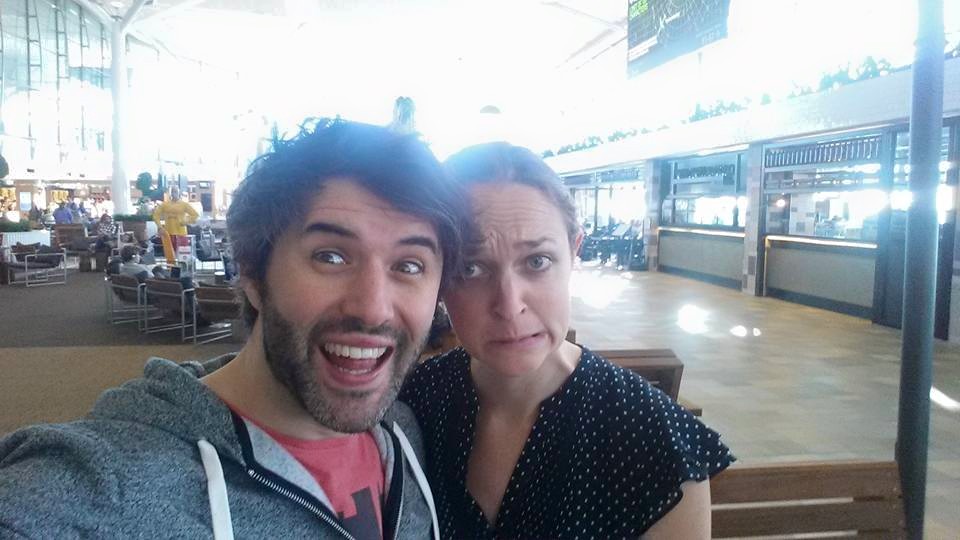By Dr James Kirby, Clinical Psychologist
 I love to travel, in fact my wife (Cassie) and I try to get overseas twice a year. We love experiencing new cultures, food, and experiences. I also find when I am in a new place I am really living in the present moment, taking in the sights, sounds, and smells. I sometimes think when I am back home I should live each day like I am a tourist, as it helps me connect with what is around me, as opposed to being on automatic pilot during the day.
I love to travel, in fact my wife (Cassie) and I try to get overseas twice a year. We love experiencing new cultures, food, and experiences. I also find when I am in a new place I am really living in the present moment, taking in the sights, sounds, and smells. I sometimes think when I am back home I should live each day like I am a tourist, as it helps me connect with what is around me, as opposed to being on automatic pilot during the day.
We returned home yesterday from Bali and Lombok in Indonesia, places we had not been before, and it was a relaxing and lovely holiday. However, this blog isn’t about the holiday itself, it is about the flight back home, and that was a bumpy ride, to put it mildly. My first overseas trip was when I was 15, I went to Japan, and on that trip I had no problems with turbulence. It has only been in the last 4-5 years where I have really started to become quite anxious when we experience turbulence on a flight. Let me give you an example, the flight will be going smoothly, I’ll be watching a movie maybe even enjoying a drink (scotch), and then ‘bump’ there will be some turbulence. What do I do? Well I grasp the armrests of my chair, in an automatic response, I guess thinking this will somehow help stabilise me. I take my headphones off, as I want to be alert, and I wait, monitoring, until I think it is safe again. And only when it is smooth flying again do I go back to watching my show. Not the greatest way to manage my anxiety when turbulence hits.
Cassie (my wife) has never had a problem with turbulence but now that we have been on so many flights together she has ‘caught’ my anxiety. The magic of conditioning. So we are now about as bad as each other and I feel very guilty about this. As we are both clinical psychologists we should be able to manage this anxiety and fear of turbulence when flying, right? Well it has been a bit of a struggle. I know about the anxiety cycle, I do controlled breathing, and I try to use some cognitive restructuring around the turbulence to help me. Sometimes these things do work, however, I still ‘feel’ on edge during the turbulence and sometimes the ‘rationalising’ doesn’t really work for me. Despite my anxiety around turbulence I have never not flown, and I always will fly. I value travelling far too much, and Acceptance and Commitment Therapy has been useful in helping me to continue to fly while still having my ‘struggle with anxiety’ as opposed to not flying at all, see Steve Hayes book “Out of Your Mind and Into Your Life”.
However, it has been Compassion Focused Therapy (CFT) that has really helped me calm down much more. CFT says that we, that is, humans, are all part of the ‘flow of life’ and as a result we have a ‘tricky’ brain. Our brains are not something that we have created or designed, rather something we have been given through years of evolution. The human brain has fantastic capabilities such as being able to imagine, create, plan, anticipate, reflect, ruminate, and have self-awareness, all of which help us to do incredible things like communicate through language and build and fly in planes. However, they can also come at an emotional cost, as this little example of a zebra will illustrate. Imagine a zebra in an African savannah eating grass. There is nothing a zebra likes to do more than eat grass. However, it then spots some rustling in the bushes, the zebra becomes alert and then runs to safety. Now 9 times out of 10 the rustling is just wind or maybe a small animal, but that one time it could be a lion, and it is better to be safe than sorry. When the zebra has found a safe spot in the savannah what does it do again? Well it goes back to eating grass, the thing it loves to do (read “Why Zebras Don’t Get Ulcers” by Robert Sapolsky). Now if you put a human brain in the zebra, what does it do when it is safe – well it thinks “Oh my goodness that was a near thing, could you imagine if it was a lion, what if it ate me? That would be awful, being eaten alive would be the worst!” Yes, as humans we tend to ruminate or ask the ‘what if’ questions over and over, which leads to more anxiety, fear and distress. And indeed that is what happens with me and my relationship with turbulence.
Paul Gilbert who developed CFT describes three key emotion systems in the human brain:
- Threat and self-protect system – helps us keep a look out for danger and to be better safe than sorry, with emotions like anger, fear, anxiety, disgust.
- Drive and resource seeking system – helps us seek out important resources, such as find food, sexual partners, friends, with emotions like excitement, joy, happiness.
- Soothing/affiliative system – helps us soothe ourselves and feel content, calm, and safe.
All of these systems are very important, however, our threat system is overly developed, and rightfully so, it keeps us alive. Remember the zebra example, we want the threat system to come online and override the other systems so it has our attention so we can be safe. We don’t need much help developing our threat system, it works pretty darn well, but we do need help developing our soothing system, something I used on my recent flight home. What’s important here is that although the emotions of fear, anxiety and anger can be very difficult, it’s not our fault for having them, it is our brain doing what it has evolved to do, and that is to see a threat and self-protect. And although it is not our fault for having these painful emotions, we do have a responsibility to learn how to help soothe them. Paul Gilbert writes about this brilliantly in his book “Mindful Compassion”.
Now going back to that flight, when the turbulence hit me I was in my threat system, I was alert. Initially it was anxiety that took hold – I was thinking “oh goodness what is wrong” (replace goodness with a profanity, your choice). I looked at Cassie, she was anxious as well, she said “Oh why is this happening?” This increased my anxiety but also made me angry I was thinking “this is ridiculous we shouldn’t be having turbulence, and this bloody turbulence is upsetting my wife”. A little bit later sadness came on board and I was thinking “poor Cassie she has never had anxiety like this before when flying, this is my fault”.
At that point my sadness made me think of CFT (this is important as sadness can be quite a helpful emotion – the movie Inside Out is a good example of this). One of the key components in CFT is to help develop our soothing system, it helps us feel safe, calm, and content. Something I needed on that flight home. Immediately I did an imagery exercise, so in my “minds eye” I imagined a safe place, a place where I feel ‘free’ and ‘comfortable’, a place that would welcome me, make me feel at home. That safe place for me is at the beach down at Burleigh Heads. I imagined the smell of the ocean, the feel of the sun on my skin, and the sights of the golden sand. That helped direct my attention away from anxiety to a place of feeling more comfortable, welcomed, and it slowed things down for me. Slowing is important. I then thought to myself “OK thanks anxiety, I know you are here to warn me, and its not my fault you are here, just my brain doing what is has evolved to do, but right now I don’t want you to run the show.”
So I then thought about my ideal compassionate image – another CFT exercise. My ideal compassionate image is someone (I don’t know the gender, for me that isn’t clear – that’s important with imagery it doesn’t have to be picture perfect, a felt sense is fine) who has a soft voice, has a welcoming embracing attitude towards me, and this compassionate image has the strength, wisdom and commitment to support me (Paul Gilbert identifies strength, wisdom and commitment as fundamental elements of compassion). I spent a few minutes imagining what it felt like to be in the presence of this compassionate image and what it felt liked to be cared for in this way. After spending a few minutes doing this I let the image fade away, and what did I notice, well I was a lot more calm, my attention had broadened to other things beyond the turbulence, like I needed a drink of water and also needed to go the toilet. I also felt comfortable to reach out to Cassie and tell her ‘hey things are going to be ok, turbulence is normal’. All of a sudden I had a calm courage, and I was focused on things that mattered, like my wife. I was no longer grasping the arm chair, I was sat back in the chair, not relaxed – like muscles all floppy, but in a state of calmness and stillness. This remained for the rest of the flight, and at differing times I went back to my safe place.
We then arrived back home, and later that night after dinner Cassie said to me “thank you for today in the plane, you really helped”. And at that point we both had the startling realisation that it was I – the one with the fear of turbulence that calmed Cassie down, and not the other way round. I mean none of this would have been a problem if I wasn’t anxious in the first place, but that was just my tricky brain at play, and that’s not my fault, but I am now learning on how to take responsibility for it.
One final important part of this story is that when I first started to engage in the calming exercises on the plane I found it very difficult and wanted to abandoned them almost straight away thinking to myself “don’t bother with this, focus on the turbulence like you usually do, otherwise how will you know it has finished” – (my threat system coming online again). This helped me deepen my empathy for what many of my anxious clients are struggling with on a daily basis. Engaging with suffering is difficult and takes courage, and that is why we all need encouragement when dealing with our fears.
Note. That photo is of Cassie and me at the airport waiting to fly
For more information on Dr Kirby visit www.psychologyconsultants.com.au

You must be logged in to post a comment.